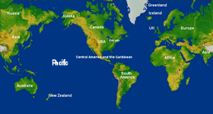
History of Rotary in the Pacific Region
Rotary entered the Pacific Region from all directions - north, south, east and west -
* The Rotary Club of Honolulu, Hawaii was the first Club in the region to be chartered (in 1915), via influence from
California, U.S.A.
* It was 21 years before influence from the South Island of New Zealand gave rise to the second club in the region - the Rotary
Club of Suva, Fiji.
* In 1939, the Rotary Club of Guam was chartered following preliminary meetings and research by the Vice-President of Rotary
International, Carlos P Romulo, and "Ray" Reynolds of the Rotary Club of Manila, Philippines.
* Port Moresby, Papua New Guinea was chartered in 1957 as a result of expansion from Australian clubs.
* Californian Rotarians were responsible for the creation of the Rotary Club of Papeete, Tahiti, French Polynesia in 1959.
* This gave rise to the Rotary Club of Noumea, New Caledonia in 1962.
* The Rotary Club of Saipan, Northern Marianas followed in 1968 with help from the RC Guam
* Tonga, Cook Is, American Samoa, Samoa, Vanuatu and Norfolk Is. doubled the
number of clubs to 14 within the next 5 years. From 1968, the number of
clubs in this region grew from the original 7 to the 18 clubs at 2008.
|


